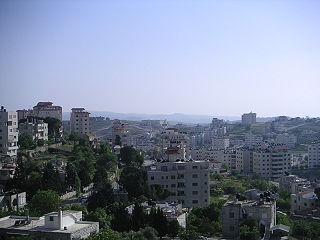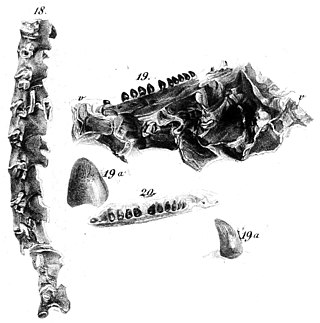The Albian is both an age of the geologic timescale and a stage in the stratigraphic column. It is the youngest or uppermost subdivision of the Early/Lower Cretaceous Epoch/Series. Its approximate time range is 113.0 ± 1.0 Ma to 100.5 ± 0.9 Ma. The Albian is preceded by the Aptian and followed by the Cenomanian.
The Cenomanian is, in the ICS' geological timescale, the oldest or earliest age of the Late Cretaceous Epoch or the lowest stage of the Upper Cretaceous Series. An age is a unit of geochronology; it is a unit of time; the stage is a unit in the stratigraphic column deposited during the corresponding age. Both age and stage bear the same name.

The Turonian is, in the ICS' geologic timescale, the second age in the Late Cretaceous Epoch, or a stage in the Upper Cretaceous Series. It spans the time between 93.9 ± 0.8 Ma and 89.8 ± 1 Ma. The Turonian is preceded by the Cenomanian Stage and underlies the Coniacian Stage.
Haasiophis, consisting of the sole species Haasiophis terrasanctus, is an extinct genus of snakes with hind limbs. It is one of three genera of Cenomanian snakes known to have possessed hindlimbs.
Pachyrhachis is an extinct genus of snake with well developed hind legs known from fossils discovered in Ein Yabrud, near Ramallah, in the central West Bank. It is a relatively small snake, measuring more than 1.5 metres (4.9 ft) long at maximum. Pachyrhachis appears to have been an ancient marine snake; the fossils occur in a marine limestone deposit, and the thickened bone of the ribs and vertebrae would have functioned as ballast to decrease the buoyancy of the animal, allowing it to dive beneath the ancient Cretaceous seas that it once inhabited.

Stomatosuchus is an extinct stomatosuchid neosuchian from the Late Cretaceous (Cenomanian) of Egypt. Much of what is known about Stomatosuchus has been inferred from the related genus Laganosuchus.

Ein Yabrud is a Palestinian town in the Ramallah and al-Bireh Governorate in the central West Bank. It is located approximately 7 km northeast of the city of Ramallah and its elevation is 800 m. According to the Palestinian Central Bureau of Statistics (PCBS) the town had a population of 2,515 in 2017.

Bothremydidae is an extinct family of side-necked turtles (Pleurodira) known from the Cretaceous and Cenozoic. They are closely related to Podocnemididae, and are amongst the most widely distributed pleurodire groups, with their fossils having been found in Africa, India, the Middle East, Europe, North America and South America. Bothremydids were aquatic turtles with a high morphological diversity, indicative of generalist, molluscivorous, piscivorous and possibly herbivorous grazing diets, with some probably capable of suction feeding. Unlike modern pleurodires, which are exclusively freshwater, bothremydids inhabited freshwater, marine and coastal environments. Their marine habits allowed bothremydids to disperse across oceanic barriers into Europe and North America during the early Late Cretaceous (Cenomanian). The youngest records of the group are indeterminate remains from Saudi Arabia and Oman, dating to the Miocene.
Saurorhamphus is an extinct genus of prehistoric fish. Fossils are known from the Late Cretaceous (Cenomanian) of the former Tethyan region, but an undescribed specimen is also known from Mexico.

The Berothidae are a family of winged insects of the order Neuroptera. They are known commonly as the beaded lacewings. The family was first named by Anton Handlirsch in 1906. The family consists of 24 genera and 110 living species distributed discontinuously worldwide, mostly in tropical and subtropical regions. Numerous extinct species have also been described. Their ecology is poorly known, but in the species where larval stages have been documented, the larvae are predators of termites.

Yabrud is a Palestinian village in the Ramallah and al-Bireh Governorate in the central West Bank. It is located approximately 13 km northeast of the city of Ramallah and its elevation is 790 m. According to the Palestinian Central Bureau of Statistics (PCBS) 2017 census, the town had a population of 575.
Haasiasaurus is an extinct genus of early mosasaur, originally named "Haasia" by M. J. Polcyn et al., in honour of the palaeontologist Georg Haas. Haasiasaurus was one of the oldest cenomanian mosasaur measuring 1 metre (3.3 ft) long. The genus contains the species Haasiasaurus gittelmani, which was found in the Cenomanian 100 million years ago rocks near Ein Yabrud, in the Palestinian West Bank, approximately 20 kilometres (12 mi) north of Jerusalem.

The Ommatidae are a family of beetles in the suborder Archostemata. The Ommatidae are considered the extant beetle family that has most ancestral characteristics. There are only seven extant species, confined to Australia and South America. However, the geographical distribution was much wider during the Mesozoic spanning across Eurasia and Australia, suggesting that they were widespread on Pangea. So far, over 26 extinct genera containing over 170 species of these beetles have been described. Three extant genera have been assigned to this family: Omma,Tetraphalerus and Beutelius. The family is considered to be a subfamily of Cupedidae by some authors, but have been found to be more closely related to Micromalthidae in molecular phylogenies. A close relationship with Micromalthidae is supported by several morphological characters, including those of the mandibles and male genitalia. Due to their rarity, their ecology is obscure, it is likely that their larvae feed on deadwood.
Flexomornis is a genus of enantiornithean birds known from fossils found in Texas rocks belonging to the Woodbine Formation dating to the middle Cenomanian age of the late Cretaceous period. It contains a single species, Flexomornis howei, named for the amateur fossil hunter Kris Howe, who discovered the site where the fossils were found.
The Cenomanian-Turonian boundary event, also known as the Cenomanian-Turonian extinction, Cenomanian-Turonian oceanic anoxic event, and referred to also as the Bonarelli event, was one of two anoxic extinction events in the Cretaceous period. The Cenomanian-Turonian oceanic anoxic event is considered to be the most recent truly global oceanic anoxic event in Earth's geologic history. Selby et al. in 2009 concluded the OAE 2 occurred approximately 91.5 ± 8.6 Ma, though estimates published by Leckie et al. (2002) are given as 93–94 Ma. The Cenomanian-Turonian boundary has been refined in 2012 to 93.9 ± 0.15 Ma. There was a large carbon cycle disturbance during this time period, signified by a large positive carbon isotope excursion. However, apart from the carbon cycle disturbance, there were also large disturbances in the ocean's nitrogen, oxygen, phosphorus, sulphur, and iron cycles.
The Amminadav Formation is a Mesozoic geologic formation in the West Bank (Palestine). Pterosaur fossils have been recovered from the formation, in addition to several ray-finned fish and early snakes, most of which are known from the Ein Yabrud quarries. The formation overlies the just slightly older Bet-Meir Formation, and it is uncertain whether most of the paleobiota belong to one formation or the other.
The Bet-Meir Formation is a Mesozoic geologic formation in the West Bank (Palestine). Pterosaur fossils have been recovered from the formation, in addition to several ray-finned fish and early snakes, most of which are known from the Ein Yabrud quarries. It underlies the just slightly younger Amminadav Formation, and it is uncertain whether most of the paleobiota belong to one formation or the other.

Coniasaurus is an extinct genus of Late Cretaceous marine squamates that range in age from Cenomanian to Santonian. It was first described by Richard Owen in 1850 from lower Cenomanian chalk deposits in southeast England (Sussex). Two species have been described from this genus: C. crassidens, known from Cenomanian to Santonian deposits from southeast England, Germany and North America, and C. gracilodens from the Cenomanian of southeast England.

Macrobaenidae is an extinct family of turtles, known from the Early Cretaceous to Paleogene of Laurasia. Their relationships to other turtles and whether they form a monophlyletic group are controversial. They are typically interpreted as stem or crown group cryptodires, but some more recent analyses have found them to lie outside crown group Testudines. Macrobaenids can be distinguished from other testudinatans by the presence of a carotid fenestra, cruciform plastron with strap-like epiplastra, and a lack of extragulars.









